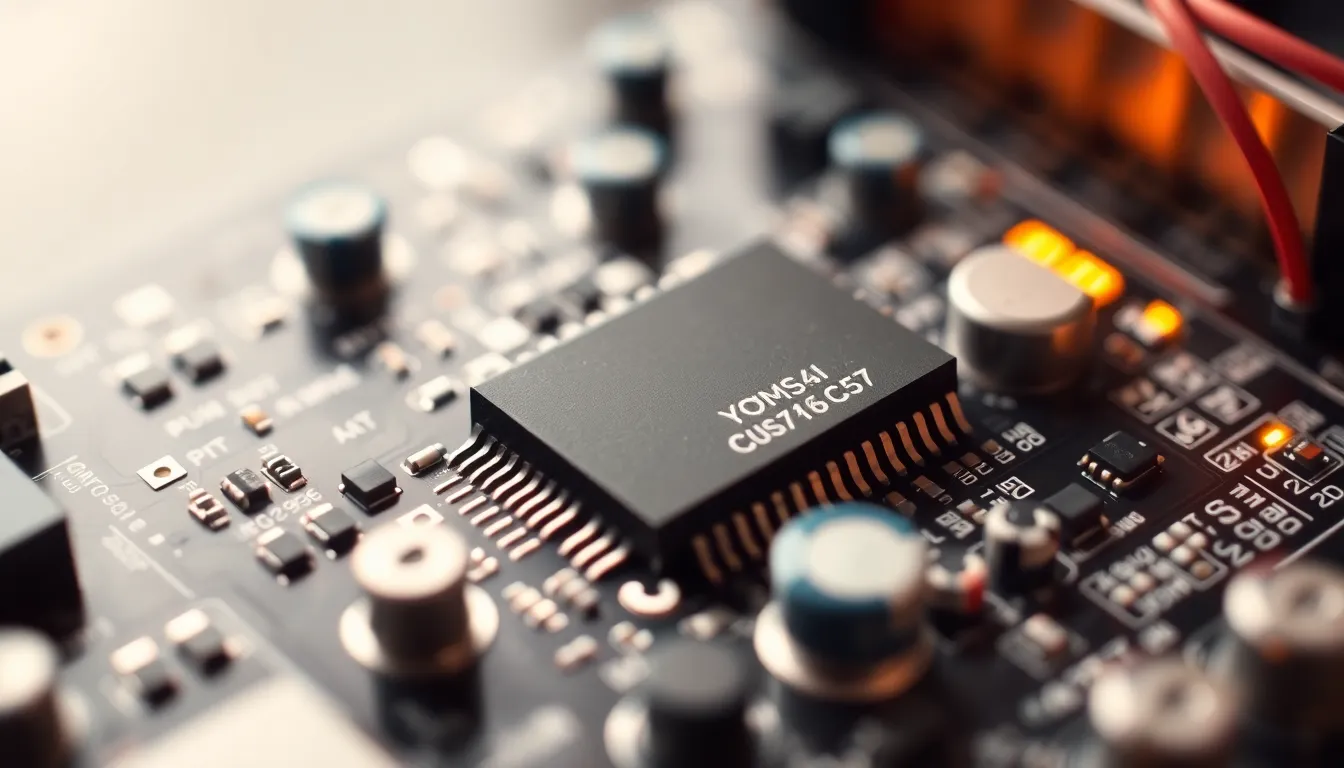In a world where everything from toasters to cars is getting smarter, embedded systems programming stands at the forefront of innovation. It’s like the secret sauce that makes everyday gadgets tick, turning mundane devices into high-tech marvels. Imagine your coffee maker brewing the perfect cup while you’re still snoozing—thank embedded systems for that morning magic!
Embedded Systems Programming
Embedded systems programming involves the development of software tailored for integrated hardware devices. These systems operate within a larger mechanical or electrical system, ensuring that the hardware performs specific tasks efficiently. A coffee maker exemplifies this concept, allowing automated brewing without user intervention.
Different programming languages are utilized in embedded systems, with C and C++ being among the most popular. C provides low-level access to memory and hardware, making it suitable for resource-constrained environments. C++ offers object-oriented features, adding flexibility for complex applications.
Key components of embedded systems include microcontrollers and real-time operating systems (RTOS). Microcontrollers serve as the central processing unit, executing programmed instructions while managing inputs and outputs. RTOS facilitates the timely and deterministic execution of tasks, crucial for applications like automotive systems or medical devices.
Developers face unique challenges in embedded systems programming. Resource limitations, such as memory constraints and processing power, demand efficient coding practices. Debugging can also be difficult due to the hardware-software interaction, requiring specialized tools for testing and validation.
Applications of embedded systems extend across various industries. Automotive systems enhance vehicle safety through features like anti-lock braking systems and adaptive cruise control. Consumer electronics, including smart home devices and wearable technology, leverage embedded programming for enhanced user experiences.
Embedded systems programming plays a vital role in modern technology. Its ability to integrate software with hardware leads to innovative, smart solutions that improve daily life.
Key Components of Embedded Systems

Embedded systems rely on several crucial components that work together to execute tasks effectively. Understanding these components is essential for grasping the foundation of embedded systems programming.
Microcontrollers
Microcontrollers serve as the heart of embedded systems. They process data and control devices through integrated processing cores, memory, and peripherals. Typically, microcontrollers feature various architectures, including ARM and AVR. These architectures influence performance and energy efficiency. Resource-efficient designs accommodate power-sensitive applications like battery-operated devices. A common example includes microcontrollers in household appliances, enabling automated features like timed cooking.
Sensors and Actuators
Sensors and actuators act as the eyes and hands of embedded systems. Sensors gather data from the environment, converting physical phenomena into electrical signals. Types include temperature, pressure, and motion sensors. Actuators respond to signals by performing physical actions, such as opening a valve or turning on a motor. Together, these components facilitate real-time interaction with the surrounding environment. In automotive systems, for instance, sensors monitor conditions while actuators adjust settings to enhance safety and efficiency.
Programming Languages Used
Embedded systems programming utilizes several key programming languages, each offering distinct advantages for specific applications.
C Language
C remains the most widely used language in embedded systems. Its low-level access enables direct interaction with hardware, making it ideal for resource-constrained environments. Many microcontrollers support C, allowing for efficient memory management and performance optimization. This language’s portability also facilitates code reuse across different platforms. Developers appreciate its simplicity for creating performance-critical applications in automotive systems or medical devices. Utilizing C often results in smaller code footprints, which is essential in embedded applications.
C++ Language
C++ enhances embedded systems programming with object-oriented features. It introduces classes and objects, promoting modularity and code reuse. With C++, developers can handle complex tasks, making it suitable for applications requiring sophisticated data manipulation. Availability of various libraries also streamlines development for diverse projects. This language is popular in domains where performance and maintainability are crucial, such as robotics and telecommunications. Leveraging C++ helps developers create scalable solutions while maintaining high performance.
Assembly Language
Assembly language provides direct control over hardware, offering the highest level of efficiency. This language allows precise manipulation of processor instructions, resulting in optimized performance for time-critical applications. It’s common in applications requiring precise timing, such as real-time systems. Developers often use assembly language to write low-level code for specific hardware architectures. Although it demands a detailed understanding of the target architecture, the benefits often justify the complexity. Adopting assembly language can lead to maximum performance in resource-limited environments.
Common Development Tools
Embedded systems programming relies on several critical development tools that streamline the process. Familiarity with these tools enhances efficiency and code quality.
Integrated Development Environments (IDEs)
IDEs serve as comprehensive platforms for building embedded software. They integrate essential features like code editing, project management, and debugging into one environment. Popular IDEs include Keil MDK for ARM development and Atmel Studio for AVR microcontrollers. Both tools provide code assistance features and allow for real-time compilation. Using an IDE makes managing complex projects easier and accelerates the development cycle.
Debugging Tools
Debugging tools are essential for identifying and fixing issues throughout the development process. JTAG debuggers enable direct communication with the microcontroller, allowing developers to inspect memory and control the execution flow. Tools like GDB facilitate debugging by providing a command-line interface for tracking program behavior. Hardware simulators also play a role, offering insight into how programs interact with physical devices. Leveraging these debugging tools significantly enhances reliability and stability in embedded systems.
Challenges in Embedded Systems Programming
Embedded systems programming presents numerous challenges due to constraints inherent in the hardware. Resource limitations often lead developers to work with minimal memory and processing power. Microcontrollers frequently possess limited RAM and flash memory, requiring careful management of resources to ensure functionality and efficiency.
Debugging issues arise from the complex interactions between hardware and software. Traditional debugging techniques may not be sufficient, as developers often need access to real-time data and states during execution. Robust tools, like JTAG debuggers, aid in identifying problems, but they increasingly become indispensable due to hardware nuances.
Another significant challenge involves ensuring real-time performance. Embedded systems often operate under strict timing requirements, necessitating precise scheduling and task management. Real-time operating systems (RTOS) play a crucial role, yet implementing them demands a thorough understanding of timing constraints and system architecture.
Maintaining compatibility across different architectures compounds the difficulties encountered in embedded systems programming. Multiple microcontroller families, such as ARM and AVR, require developers to adapt their code to optimize performance and integrate features specific to each architecture.
Security concerns also emerge as embedded systems connect increasingly to the internet. With rising threats targeting IoT devices, developers must prioritize secure coding practices. Implementing encryption and secure communication protocols becomes vital for safeguarding sensitive data.
Finally, software updates introduce their own set of challenges. Developers must ensure that updates are seamless and do not disrupt system functionality. Balancing feature enhancements with system stability requires meticulous planning and testing to avoid compromising performance.
Conclusion
Embedded systems programming is at the forefront of technological innovation. Its ability to transform ordinary devices into smart solutions enhances convenience and efficiency in daily life. As developers navigate the complexities of resource constraints and debugging challenges, they continue to push the boundaries of what’s possible.
The integration of robust programming languages like C and C++ ensures that these systems can operate effectively within their limitations. With the increasing reliance on embedded systems across various industries, the importance of skilled programmers in this field cannot be overstated. They play a crucial role in shaping the future of technology, driving advancements that improve safety, usability, and overall user experience.



